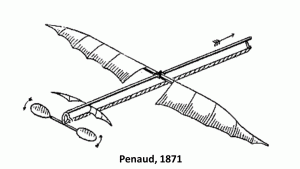If you’ve ever played with a rubber band-powered model plane, you have Alphonse Penaud to thank for it. In 1871 he was the first to use “strands of twisted india rubber” to drive a propeller, and his simple little models were crucial to figuring out things like how far along the fuselage to place the wings.
Chanute called Penaud “a very ingenious man,” and described his model as “quite successful upon the small scale on which it was tried.”The most important feature of this apparatus is that it “showed experimentally that it furnished automatic equilibrium.” That’s huge – maintaining equilibrium was one of the most difficult, persistent, and deadly problems faced by early aviators.
Unfortunately, Penaud’s impressive achievements and important insights were not recognized by his peers. Discouraged by being “criticized, decried, and misrepresented,” as well as dealing with a painful medical condition, he took his own life at the age of 30. I think of him every time I fly a rubber band powered toy plane, and I hope you will too.
LESSON: It’s possible to do big science with small, simple experiments. Also, haters gonna hate, so shake it off.
